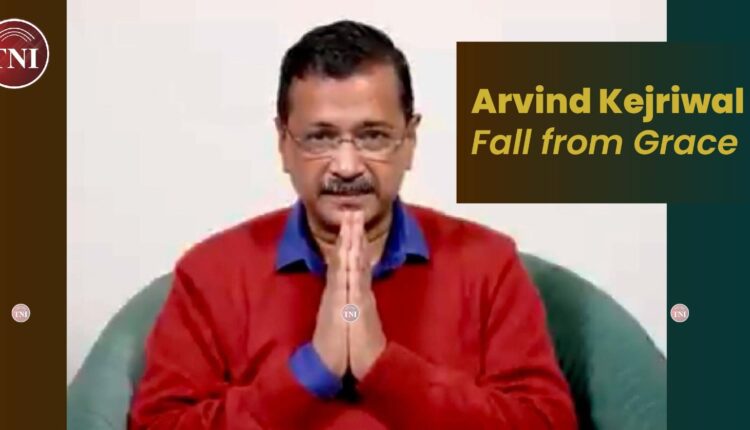Arvind Kejriwal: Fall From Grace
From a crusader against corruption to a politician embroiled in scandals, his downfall was shaped by multiple factors—legal troubles, governance failures, and a shifting political landscape.
Arvind Kejriwal’s stunning defeat in the 2025 Delhi elections marks a dramatic fall for a leader once seen as the face of alternative politics in India. The BJP secured 48 seats according to the Election Commission of India (ECI) while AAP managed to capture 22 seats resulting the exit of the party from Delhi. From a crusader against corruption to a politician embroiled in scandals, his downfall was shaped by multiple factors—legal troubles, governance failures, and a shifting political landscape.
The Corruption Allegations and Legal Troubles
The biggest blow to Kejriwal’s image was his arrest in 2024 over the Delhi liquor policy scam. Once a leader who prided himself on integrity, his refusal to resign after serious corruption allegations shattered public trust. Even though he claimed the case was politically motivated, the damage was done. AAP’s entire brand was built on fighting corruption, and these allegations turned its strongest asset into its greatest weakness.
Governance and Leadership Challenges
While Kejriwal’s governance model—free electricity, healthcare initiatives, and education reforms—was initially well-received, critics argue that over time, these policies became more about populism than sustainable governance. Infrastructure issues, pollution control failures, and deteriorating public services eroded confidence in his administration. Additionally, his confrontational approach towards the central government often led to political deadlocks rather than solutions, frustrating Delhi’s voters.
Internally, AAP also struggled with leadership issues. The party, once built on transparency and collective decision-making, saw growing centralization of power around Kejriwal and his close aides. The exit of several founding members over the years signaled deeper internal rifts that eventually hurt the party’s stability.
BJP’s Strategy and the National Political Climate
Kejriwal’s political expansion beyond Delhi, particularly in Punjab and Gujarat, may have stretched AAP too thin. Meanwhile, the BJP, with its massive organizational machinery, capitalized on AAP’s vulnerabilities. The saffron party strategically highlighted Kejriwal’s legal troubles, questioning his moral authority. With Narendra Modi’s strong leadership appeal and the BJP’s focus on national security and development, Kejriwal’s local governance promises seemed less compelling.
Support Independent Journalism? Keep us live.
The Infamous Betrayals
Arvind Kejriwal’s rise in politics is marked by several betrayals, starting with Anna Hazare, the mentor who led the India Against Corruption movement. While Hazare envisioned a non-political movement, Kejriwal went against his wishes and formed the Aam Aadmi Party (AAP), using the movement’s momentum for his own political ambitions. Later, he sidelined key figures like Yogendra Yadav and Prashant Bhushan, who were expelled from AAP in 2015 for questioning his leadership and decision-making. Similarly, poet-politician Kumar Vishwas, once a close friend and founding member of AAP, was marginalized after he raised concerns about Kejriwal’s growing authoritarianism. These betrayals painted a picture of a leader willing to discard even his closest allies for power, raising doubts about his commitment to ethical politics.
He also allegedly used Atishi as a temporary face for AAP by appointing her as the Chief Ministerial candidate ahead of the 2025 Delhi elections, only to later replace her with himself. When Kejriwal resigned as CM in 2024 due to legal troubles, Atishi was projected as his successor, gaining public and party support. However, as elections neared, Kejriwal reinserted himself into the race, sidelining Atishi despite her efforts to lead AAP through its crisis. This last-minute switch not only undermined her credibility but also contributed to the party’s poor performance, raising questions about Kejriwal’s leadership and internal party dynamics.
Curse Of Swati Maliwal
Swati Maliwal, once a close ally of Arvind Kejriwal and a prominent social activist serving as the chairperson of the Delhi Commission for Women, has since become one of his most vocal critics. Their partnership, which once symbolized the progressive ethos of the Aam Aadmi Party, unraveled following a controversial incident in May 2024 when Maliwal alleged misconduct involving a senior aide at the Chief Minister’s residence. In the aftermath, she accused the party of straying from its founding principles, a rift that has come to reflect broader internal challenges within the AAP. This evolving conflict between the two figures highlights the shifting dynamics in Delhi’s political landscape and underscores the complex interplay of personal and ideological differences at the heart of contemporary governance.
The Sheesh Mahal Controversy
The Sheesh Mahal controversy erupted when reports surfaced about Arvind Kejriwal allegedly spending over ₹45 crore on renovating his official residence in Delhi. The opposition criticized him for hypocrisy, arguing that a leader who once promoted austerity was now indulging in luxury. The BJP and Congress used this issue to attack Kejriwal, calling it a betrayal of his “common man” image. However, AAP defended the expenses, claiming the house was in poor condition and needed repairs. While the controversy dented Kejriwal’s image, electoral outcomes depended more on governance issues and political strategies than on his residence.
The 2025 elections were not just a loss in numbers but a verdict on Kejriwal’s credibility. Losing his own seat was a symbolic end to his dominance in Delhi politics. His resignation as Chief Minister marked the conclusion of an era that started with immense hope but ended in controversy.
Kejriwal’s fall from grace is a classic case of how political momentum, once lost, is difficult to regain. Whether he can reinvent himself or fade into political oblivion remains to be seen.


Comments are closed.